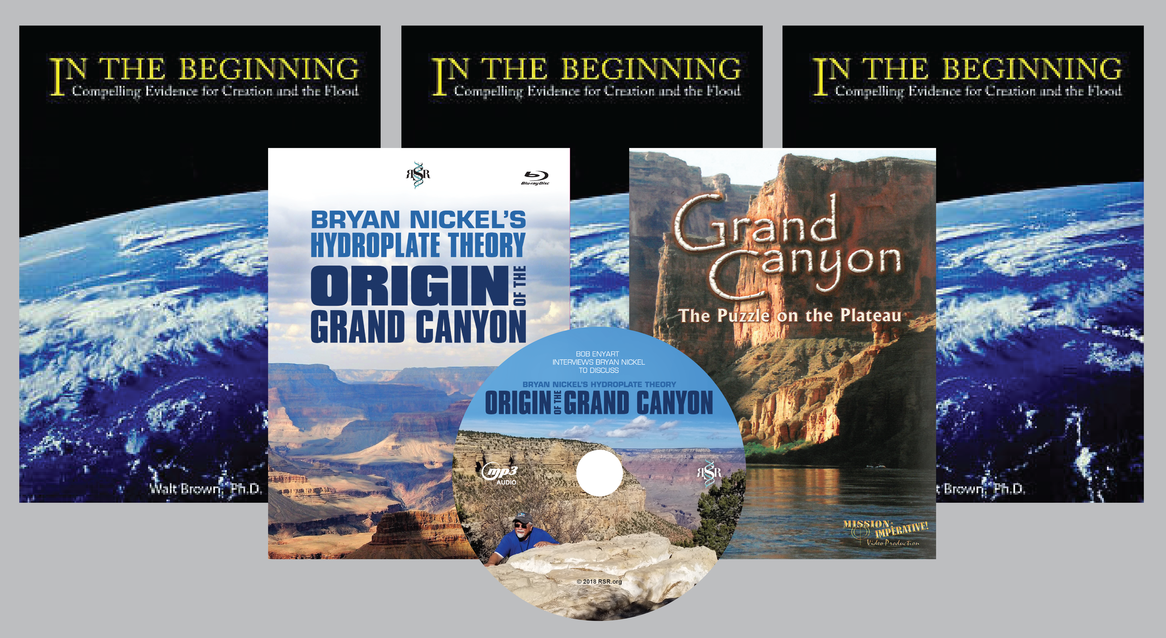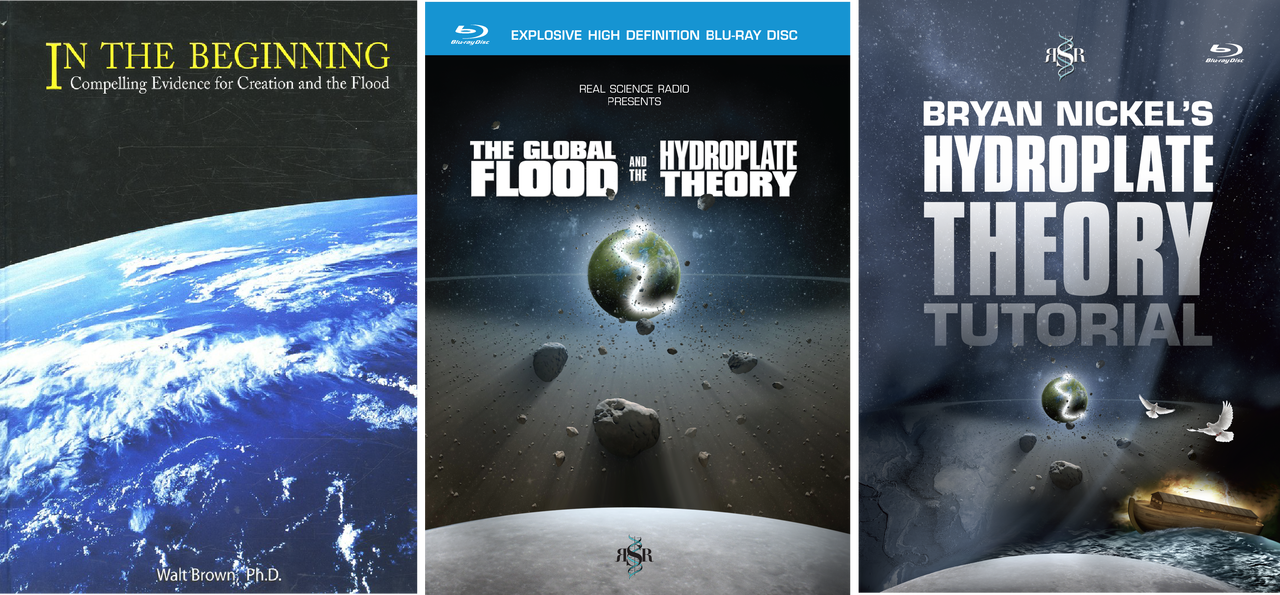
The River Didn't Carve the Canyon! (See list just below.) June is Grand Canyon month at RSR. Real Science Radio host Bob Enyart interviews Bryan Nickel about his video on the origin of one of the seven wonders of the world, the Grand Canyon. At 277 miles long, a mile deep, and 10 miles wide, much evidence disproves the claim that the Colorado River carved the canyon. Some of the world's leading geologists admit both a lack of evidence for the river hypothesis and that they don't know how it could have done so.
RSR's Grand Canyon HPT Series:
- List of Problems with ‘The River Carved the Canyon’
- List of Problems with the Canyon’s Millions of Years
- List of Problems with ‘The Flood Carved the Canyon’
- The Initial Conditions that Preceded the Canyon (& plagiarism)
- The Hydroplate Theory Explanation for the Grand Canyon
- Bonus material: (All part of rsr.org/hpt#metaseries)
Dr. Walt Brown's Canyon RSR Interview
Answering Michael Oard's Missing Grand Lake Shoreline
Answering Don DeYoung's Lawsuit Accusation
Debrief: RSR's Field Trip to the Canyon with Walt
List of Problems with 'The River Carved the Canyon'
- Rivers don't continually erode deeper and deeper into their beds partly because they have bottom sediments that prevent them from continually eroding downward.
- No other river has carved anything like the Grand Canyon even though more than 130 other rivers have much greater volume (discharge) than the Colorado, from 3 to 300 times the Colorado's relatively meager flow of 640 cubic meters per second.
RSR listener and former law enforcement officer, wrote: "Bob, my grandma would make her plans 'providing the Lord is willing and the crick don't rise! Of course a crick to her is a creek to us. So when my cousin Cindy visited we spent a week in the mountains and she was excited to see the Colorado River, the river that carved the Grand canyon! When I pointed it out to her she said, That ain't no river that's a crick! It's no wonder she said that, as with everyone in Pittsburgh, we grew up with three rivers, the Ohio, the Allegheny, and the Monongahela. Compared to the Ohio, for sure, she's right. The Colorado is a crick!"
* RSR's Grand Canyon Special: Help spread the word, get better informed, and keep us broadcasting by purchasing RSR's $100 Grand Canyon Special, our canyon radio series on disc, two stunning videos, and three copies of Walt Brown's book!

- The inner gorge is a crack in erosion-resistant and sediment-protected crystalline rock that is much harder than the sedimentary layers of the main canyon. River water would instead have excavated the softer sediments on the banks rather than cut into the bed’s much harder solid rock and like rounded river rocks, would have smoothed the walls of the gorge, which instead are jagged. (Coming in Part 3: The 1,000-foot-deep, 46-mile long tension crack of the inner gorge opened in the floor of the Grand Canyon when the weight of the overlying rock was removed.)
- None of the geologic faults in the area could have helped the river carve the canyon because they run perpendicular to the river.
- Rivers don’t flow uphill, which the Colorado would have had to do to, flowing through the uphill topography with the highest rim of the canyon at 4,000 feet elevation above where the river flows into the canyon. The river proponents claim two actions were coordinated for millions of years, that at approximately the same rate that the Colorado Plateau was uplifted, the river eroded downward. As an analogy, consider the Faint Young Sun problem, whereby the Earth's atmosphere changed over hundreds of millions of years to trap less heat as the Sun evolved to today's stability and temperature. The river eroding downward at the same rate as the plateau uplifted is another of the countless "just so" stories that make up the uniformitarian belief system.
- Rivers don't ignore all their paths of least resistance which the Colorado would have had to do for millions of years if it carved the canyon.
- Standard texts acknowledge lack of direct evidence: In the section titled, "The Evidence" in the chapter on the "History of the Grand Canyon and of the Colorado River", the 2003 Oxford University Press text edited by Beus and Morales states, "many people are taken aback by the lack of hard data pertaining to the history of the Colorado River [and its carving of the Canyon]. It is true that we do not have much direct evidence..." This is why for searches for: origin of the grand canyon, Walt Brown's explanation is the #1 Google ranked result out of 25 million relevant pages! Because while people are "taken aback" by the missing evidence for the river hypothesis, there is a tremendous amount of evidence for Walt's theory for the origin of the grand canyon!

- The massive side canyons cannot be explained by the river carving the canyon because rivers don't take dozens of abrupt right and left turns to flow out some miles and then back in on themselves.
- The many side canyons cannot be explained by multiple rivers carving them because there is no evidence of dozens of ancient rivers and there are no sufficiently-sized drainage basins to feed the non-existing ancient rivers.
- The side canyons cannot be explained by rainfall erosion which is the only option left in a river-carved-the-canyon model. The relatively minimal rainwater provided by the canyon's arid climate could not perform the needed massive erosion and sediment transport. Arizona is the fourth driest of the 50 U.S. states. Further, the claim that the massive side canyons were carved by rainwater contradicts the condition in the scores of layers of the Grand Canyon showing flat gaps, i.e., the amazingly parallel boundaries, called paraconformities, with characteristically little to no evidence of rain erosion. The many ways to disprove the uniformitarians is that they want to have it both ways: a lot of rain erosion for the side canyons and virtually no rain erosion throughout the far greater extent of the strata itself.
- Marble Canyon's dozen barbed side canyons can't be explained by the Colorado River. As part of Grand Canyon National Park, Marble Canyon leads directly into the main canyon. As an analogy, consider that the Mississippi River's tributaries flow, as expected, from north to south, consistent with the Mississippi and the overall system's drainage basin. In Marble Canyon, a river explanation cannot account for its series of backward side canyons that allegedly would have been formed by tributaries flowing uphill against the topography of the Colorado River’s southwestward drainage basin.
- The massive sheet erosion of the great denudation off 10,000 square miles can't be explained by a river. From above what is today the top of the Grand Canyon, like when you’re standing on its north and south rims, 1000-feet of sedimentary rock had to first be excavated from a 10,000 square-mile area. Geologists call this excavation the great denudation, removing the strata that connected and extended far beyond Echo and Vermillion Cliffs. However, that had to happen before the much smaller Grand Canyon could even get started (and any canyon theory must as a prerequisite explain the denudation). Yet of course, a river cannot perform sheet erosion of thousand-foot-thick sediments over a wide and vast region of 10,000 square miles.
- The "potholes" atop Echo Cliffs: The cliffs in the above image (Echo to the left facing Vermillion Cliffs to the north) outline "the funnel" breach point where Grand Lake catastrophically drained and excavated the Grand Canyon. The initial breach was a shallow overflowing of the lake's rim when early in the process the flooding carved hot-tub sized "potholes" into the sedimentary layers on the top of and very near the edge of Echo Cliffs! (Hear this at 25 minutes into rsr.org/gc5 and see it in Bryan's video starting at 56:45.)
- The Colorado River’s delta is tiny compared to the amount of rock removed from the denudation and excavated from the canyon, and it’s tiny compared to many of the world’s other river deltas, none of which need to account for the sediments of a grand canyon. (See comparison satellite photos above.)
All observations indicate that the river didn’t carve the canyon but the river is the result of the canyon. The river didn’t cause the canyon. The canyon caused the river.
* RSR's Hydroplate Theory Special: You may want to purchase this set of resources if...
1) You'd like to read the best creation book ever written and watch its accompanying videos
2) You like Real Science Radio and want to help it stay on the air
3) You'd like to give the gift of understanding creation and the flood to someone who could really benefit from it.
* A River Also Didn't Carve this Tibetan Gorge, As Previously Thought: According to the journal Science (2014, vol. 346), the world's deepest gorge (canyon), even longer than the Grand Canyon, was quickly eroded after a rapid uplift, and not carved by the Yarlung Tsangpo River as long claimed:
The constant river gradient strongly suggests a rapid uplift event created the gorge, rather than the river incision as previously believed.

* Want to Go from Geology to Cosmology? Here's RSR's latest science video:


